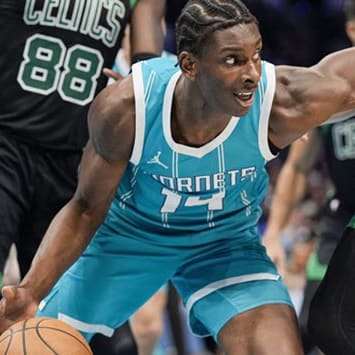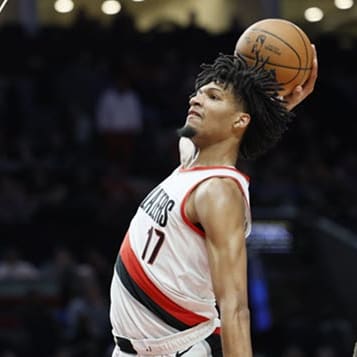This article is part of our Fielkow's Law NBA series.
By now, many NBA fans have heard of Montenegrin star Nikola Mirotic, who will be donning an NBA uniform for the first time in 2014 after inking a three-year, $17-plus million contract with the Chicago Bulls in July. According to ESPN analyst Fran Fraschilla, the sweet-shooting Mirotic would have been a top-4 pick in the stacked 2014 NBA Draft. But back in 2011 when Mirotic was drafted, few knew his name. So how exactly does a player who hails from a country that is smaller than Connecticut find himself being one of the key offseason additions for an NBA team with championship aspirations? The answer, in a word, "stash."
In the 2014 NBA Draft, 13 players between the ages of 19 and 22 who did not attend college in the United States or Canada were drafted. In 2013, a whopping 19 such players were selected. Contrary to their American counterparts, however, the vast majority of these international prospects will provide no immediate help to their drafting teams in raising the Larry O'Brien Trophy. So what gives? There are often three main reasons for the "draft-and-stash" approach employed by many NBA teams: 1. developmental reasons; 2. roster space; and 3. contractual issues.
Often, development concerns and insufficient roster space go hand-in-hand. Not all players are ready to step on an NBA court immediately after being drafted. While the NBA Development League is a useful tool for teams to develop young talent, allowing a player to continue to play internationally is another equally viable alternative. Further, for teams in win-now mode, there may be a shortage of roster spots. It makes little sense for a competitive team to tie up a valuable roster spot with a young player who likely won't see much of the floor when that same prospect could be playing regularly and honing his skills overseas.
The third reason why NBA fans may not get a glimpse of a budding international star until years after he is drafted is the same reason that has stymied the offensively-challenged Bulls' pursuit of Mirotic for years prior: international contracts. The NBA has a formal agreement with the Federation Internationale de Basketball (FIBA) recognizing each other's contracts. A player who is currently playing or last played on a FIBA team must obtain a letter of clearance from the basketball federation of the country in which he played before signing with an NBA team. The letter of clearance ensures that the player does not have an "existing and validly binding" contract with any FIBA team.
NBA teams signing international players they drafted are allowed to pay a buyout to the player's team or organization in order to release the player to sign in the NBA. This, in theory, seems simple given the ample resources available to the teams stateside. But, the Collective Bargaining Agreement (CBA) between the NBA and the Players' Association -- whose nuances have been known to make grown men curl up into the fetal position -- contains a provision that directly relates to buyouts of international players, which complicates things. Under the CBA, NBA teams are allowed to pay up to the "Excluded International Player Payment Amount," which for the 2014-15 season is $600,000. This amount is not charged to the team's salary cap. Buyouts can, however, exceed the Excluded International Player Payment Amount, but any such excess comes out of the player's salary (i.e. if a player and their overseas team agree to a buyout of $1 million, the NBA team may only pay $600,000 of that buyout, and the international player is responsible for the other $400,000). Not only that, but any amount above the Excluded International Player Payment Amount is counted against the NBA team's salary cap (as a signing bonus)*. This buyout contribution limit is the main reason it took players like Ricky Rubio (whose 2009 buyout from his international team, Joventut Badalona, was reportedly upwards of $8 million) and Mirotic so many years to finally come stateside, despite their obvious talent.
*It's even trickier to pay more than the excluded amount for a first-round draft pick, which is why international players with large buyouts often drop to the second round of the draft. CBA guru Larry Coon provides an excellent analysis for nerds like myself interested in the intricacies of the NBA salary cap.
With the NBA still experiencing an international renaissance -- with future Hall-of-Famers such as Dirk Nowitzki and Tony Parker still world class and an up-and-coming generation of ballers like Giannis Antetokounmpo and Jonas Valančiūnas proving their worth -- it begs the question: what can fantasy owners reasonably expect from Mirotic?
Said Fraschilla, "I think [Mirotic] would have been the guy like we said with Jabari Parker, he's the most ready to play in an NBA game right now." Mirotic has been described as the "Next Toni Kukoc" and "possibly the best European player since the great Dirk Nowitzki." According to others, "a worst-case scenario would be Ryan Anderson." While certainly hyperbolic praise for a player who has yet to step foot on an NBA court, there's no denying the 6-10 Mirotic's credentials. Two-time Spanish King's Cup winner (akin to the NBA Finals in Spain). Spanish league MVP in 2013. Back-to-back Euroleague finals in 2013 and 2014, earning second-team All-Euroleague honors in the process -- the youngest player in over a decade to be selected to an All-Euroleague team. And the only player in Euroleague history to win the Rising Star Award (given to the best young player) twice.
Mirotic shot 53.7 percent from the field and 41.6 percent from three in Euroleague competition last season, and as the only player in Euroleague to rank in the top 15 in scoring, steals, blocks, and player efficiency rating, Mirotic has the goods to stretch the floor offensively and serve as a capable defender in Bulls coach Tom Thibodeau's defense-oriented scheme. The biggest problem for Mirotic, however, will be finding playing time in the Bulls' suddenly-loaded frontcourt. Free-agent addition Pau Gasol will serve as an upgrade over the amnestied Carlos Boozer, joining forces in Chicago with incumbents Joakim Noah and Taj Gibson. While Thibodeau isn't apt to playing his rookies, it's unquestionable that the Bulls' offense needs a jolt, and Mirotic's outside shooting will earn him minutes.
But the question remains just how many minutes? In a best-case scenario to start the season, Mirotic is the second man off the bench after Gibson (or more likely, Gasol if Gibson starts) who provides a floor stretcher for the only team in the NBA last year that didn't have a power forward or center with a made three-pointer. The Bulls could even get creative at times, deploying a jumbo lineup featuring Mirotic at small forward. With Gasol and Noah both having a checkered injury history, the Bulls may also be forced to lean more heavily on Mirotic if either goes down for an extended period of time. As the season progresses, it's not unreasonable to think Mirotic's minutes (and hopefully production) will grow as Thibodeau becomes more comfortable deploying the skilled power forward.
There will certainly be some growing pains for Mirotic in his first year in the NBA. Though he had the chance to hone his skills overseas, the NBA is a step up in class from its European counterparts. But like so many international players before him, the future is bright for the talented youngster, and there's plenty of reason for fantasy owners to hope that he can be an asset sooner rather than later.











